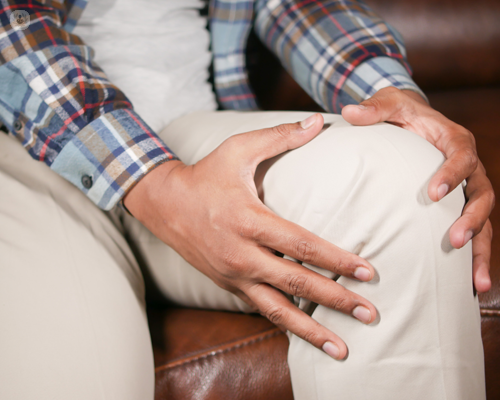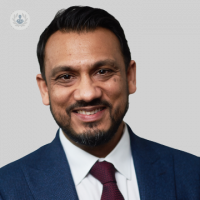A guide to knee cartilage restoration
Written in association with:There are various reasons why knee cartilage restoration may be required, but what’s involved in the different types of procedures for this? Leading orthopaedic knee surgeon Mr Saket Tibrewal goes into expert detail in this informative article.

What is knee cartilage restoration?
Knee cartilage restoration is a surgical technique which regenerates (repairs) damaged articular cartilage in the knee joint. It can be done by either stimulating new growth or by transplanting cartilage into areas with defects, in order to relieve pain and restore the knee’s normal function.
Articular cartilage damage can occur due to:
- normal wear and tear of the knee joints;
- increasing age;
- injury, or;
- other disease conditions.
When cartilage is damaged, it can cause various symptoms. These include:
- severe pain;
- inflammation;
- stiffness, and;
- decreased range of motion of the knee.
Cartilage has an avascular nature (absence of blood supply), which means that cartilage cannot repair itself. Therefore, surgical treatment is usually required to restore cartilage function and prevent the damage progressing into arthritis.
Articular cartilage anatomy
Articular cartilage is a smooth, shiny, white tissue. It covers the ends of bones that form a joint. It reduces friction when bones glide over each other, and this makes the movements smooth and painless. Also, it acts as a shock-absorber to help in prevention of traumatic bone injuries.
Who is suitable for a knee cartilage restoration procedure?
Knee cartilage restoration is suitable for patients with deterioration of knee cartilage or have damage as a result of:
- Repetitive use of the knee joint
- Injury or trauma
- Hormonal conditions, for example osteochondritis dissecans (OCD)
- Congenital deformities.
How do patients prepare for knee cartilage restoration?
Preoperative preparation for knee cartilage restoration involves the following:
- A thorough medical examination to check for any issues that need to be addressed before surgery.
- Routine blood work and imaging may be ordered depending on medical history, social history, and age, so the procedure can be done safely.
- It will be verified if the patient has any allergies to medications, anaesthesia, or latex.
- Patients should inform their doctor of any medications, vitamins, or supplements they may be taking.
- Medications or supplements such as blood thinners, aspirin or anti-inflammatory medicines should be avoided for a week or two prior to surgery.
- Any solids or liquids shouldn’t be consumed for at least six hours before the procedure.
- Patients won’t be able to drive yourself post-surgery, so it’s important to arrange for someone to drive them home.
- Written consent will be obtained from the patient after the surgical procedure has been explained in detail.
What are the different types of surgical procedures for knee cartilage restoration?
Some cartilage restoration procedures can be performed arthroscopically. This is a minimally invasive (keyhole) surgery that involves making small incisions around the knee joint and using an arthroscope. This is a small flexible tube with a light and video camera at the end. It enables the surgeon to view inside of the joints and perform surgery. Open surgery may be required in certain cases to access the affected area requiring longer incisions. The best surgical options for each patient will be discussed.
Recovery from an arthroscopic procedure is usually faster, and patients experience less pain than traditional, open surgery.
Some of the most common methods for knee cartilage restoration are:
Microfracture: A sharp tool is used to create numerous holes in the injured joint surface using a sharp tool. This stimulates a healing response by creating a new blood supply, and results in the growth of new cartilage.
Drilling: A drilling instrument is used to create holes into the injured joint’s surface. This creates blood supply and stimulates the growth of new cartilage.
Abrasion arthroplasty: This procedure is similar to drilling but instead of drills or wires, a high-speed metal-like object is used to remove the damaged cartilage.
Osteochondral autograft transplantation (OATS): With this method, healthy cartilage tissue (graft) is taken from the bone that bears less weight. The graft is then transferred to the injured area. OATS is used for smaller cartilage defects.
Osteochondral allograft transplantation: A graft is taken from a donor and transplanted to the site of the injury. If a larger part of the cartilage is damaged, this technique is recommended.
Autologous chondrocyte implantation: Using an arthroscopic technique, a piece of healthy cartilage from another site is removed. It is then cultured in the laboratory. These cultured cells form a larger patch, and it is then implanted into the damaged part via open surgery. This is a two stage (two surgery) procedure.
Autologous Minced Cartilage Implantation: This is a newer technique where a small amount of cartilage is removed from the patient, which is then minced into tiny pieces to significantly increase its volume, and implanted to fill the defect.
Scaffold (Autologous Matrix Induced Chondrogenesis): An off the shelf tissue is used to fill the defect and this acts as a scaffold for the development of new cartilage. This is a single stage procedure.
What should patients do about postoperative care?
Postoperative care and recovery after knee cartilage restoration generally involve the following:
- Patients are transferred to the recovery area. Here, they are monitored until they wake up from the anaesthesia.
- A nurse will monitor patient’s blood oxygen levels and other vital signs as they recover.
- Crutches will be assigned for the first few weeks with instructions on restricted weight-bearing. Patients are encouraged to walk with assistance as frequently as possible. This helps to prevent blood clots.
- Patients are advised to keep the leg elevated while resting. This helps to prevent swelling and pain.
- Pain and discomfort in the knee area may be present. Medications will be provided for relief.
- A range of motion exercises and physical therapy are both advised. These help to restore mobility and strengthen the joints and muscles.
- Anti-nausea medications will be prescribed as required, to provide relief for discomfort associated with anaesthesia.
- Patients should keep the site operated on clean and dry for at least 48 hours. Care and bathing instructions will be provided.
- Smoking isn’t advised as it can negatively affect the process of healing.
- It’s recommended to gradually increase activities over a period of time.
- A follow-up appointment to monitor your progress will be scheduled.
What are the risks and complications of knee cartilage restoration?
Knee cartilage restoration is a relatively safe operation. However, there are risks and complications that could occur, as with any surgery, such as:
- Blood clots, or deep vein thrombosis
- Post-operative bleeding
- Infection
- Joint stiffness
- Graft failure
- A numb sensation around incisions
- Possibility of injury to vessels, nerves, or healthy cartilage
- An allergic reaction
- Graft loosening.
If you require a consultation regarding knee cartilage restoration, arrange a consultation with Mr Tibrewal via his Top Doctors profile.


